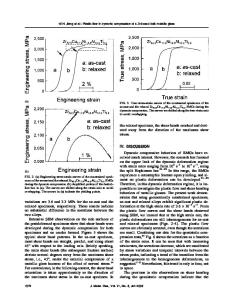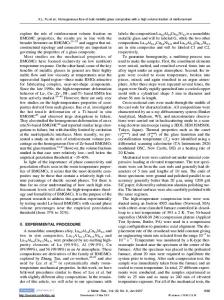Ultrasonic-assisted plastic flow in a Zr-based metallic glass
- PDF / 3,111,914 Bytes
- 12 Pages / 595.276 x 793.701 pts Page_size
- 67 Downloads / 293 Views
Published online 21 August 2020 | https://doi.org/10.1007/s40843-020-1411-2
Ultrasonic-assisted plastic flow in a Zr-based metallic glass 1*
1
1
2
1
2
2
Chenchen Yuan , Zhuwei Lv , Changmeng Pang , Xin Li , Rui Liu , Can Yang , Jiang Ma , 3* 3,4 1* Haibo Ke , Weihua Wang and Baolong Shen ABSTRACT Ultrasonic vibration can be used for the micromolding of metallic glasses (MGs) due to stress-softening and fast surface-diffusion effects. However, the structural rearrangement under ultrasonic vibration and its impact on the mechanical response of metallic glasses remain a puzzle. In this work, the plastic flow of the Zr35Ti30Cu8.25Be26.75 metallic glass with the applied ultrasonic-vibration energy of 140 J was investigated by nanoindentation. Both Kelvin and MaxwellVoigt models have been adopted to analyze the structural evolution during the creep deformation. The increase of the characteristic relaxation time and the peak intensity of relaxation spectra can be found in the sample after ultrasonic vibration. It effectively improves the activation energy of atomic diffusion during the glass transition (Eg) and the growth of the crystal nucleus (Ep). A more homogenous plastic deformation with a weak loading-rate sensitivity of stress exponent is observed in the ultrasonic-vibrated sample, which coincides with the low pile-up and penetration depth as shown in the cross profile of indents. The structural rearrangement under resonance actuation demonstrated in this work might help us better understand the defect-activation mechanism for the plastic flow of amorphous systems. Keywords: plastic deformation, disordered structure, activation energy, metallic glass
INTRODUCTION Structural tailoring is important for the mechanical performance of metallic glasses (MGs) [1]. The plastic flow of MGs is proposed to be closely related to structural rearrangement at the atomic scale during deformation. Zr-based MGs are typical MG systems that show superplastic deformation at room temperature [2–4]. It has
been proved that Zr35Ti30Cu8.25Be26.75 can be microformed by using the ultrasonic-vibration technique [5]. Lateral extrusion experiments of the Zr55Cu30Al10Ni5 MG with low-frequency vibration also reveal an enhanced micro-formability under vibratory loading [6]. Microhoneycomb structures with various pitches between adjacent cells are hot-embossed on the Zr35Ti30Cu8.25Be26.75 MG to improve its frictional behavior [7]. The ultrasonic stress-softening effect, stress superposition effect, and periodic separation originating from ultrasonic vibration can effectively improve the micro-formability via a reduction of the forming force and a decrease in friction at the interface [8–10]. The shear-deformation performance of MGs is also influenced by ultrasonic vibration [11]. High-frequency ultrasonic beating method to fabricate micro- to macro-scale structures [12,13] can avoid the crystallization and oxidation of MGs, implying the potential application of this technique in micromachining MGs. The fast surface dynamics near the bondi
Data Loading...











